Refreshed Best-Selling Hyundai
The 2021 Tucson was first-ever hybrid SUV from Hyundai, delivering increased fuel economy while seating five and hauling all their stuff. Great as that was, Hyundai was not done as work was underway for the refreshed and updated 2025 Tucson Hybrid that is now in dealers. With changes to the exterior, interior, infotainment system, safety, tech, and even something called Baby Mode, the refreshed Tucson Hybrid is definitely worth a look.
The Tucson, available in five trims, has three propulsion options—gasoline, gas-electric hybrid and gas-electric plug-in hybrid. Within those are trims of the N Line appearance package and XRT, which offers a bit more ruggedness for light off-roading. Hyundai is hoping there is something for everyone looking for a compact SUV.

Hyundai’s Best-Selling Vehicle
Hyundai invited the automotive media to the beautiful Inn at Mattei’s Tavern in Los Olivos, California, to sample the 2025 Tucson hybrid, but also get a taste of the 2025 Santa Fe SUV and the Santa Cruz compact pickup. We drove the Tucson Hybrid through vineyards and cattle country of the Santa Ynez Valley as well as mountains and freeways. We experienced the SUV’s smooth operation and more-than competent handling, especially when pushing above the posted corner speed limit.
Effortless Efficiency
The 2025 Hyundai Tucson Hybrid is powered by a 1.6-liter turbocharged 4-cylinder engine producing 178 horsepower and 195 pound-feet of torque. Adding-in the 64 kW electric motor for a total system output of 231 horsepower and 271 pound-feet of torque.

All Tucson Hybrids come with Hyundai’s HTRAC AWD. This electronically controlled AWD system has an active on-demand capability to seamlessly go between four-wheel drive and front-wheel drive. This system is designed to maximize both fuel economy and traction depending on the road conditions. There is a button to lock the center coupling, which sends 50-percent traction to the front and rear axles so in slippery conditions, it reduces or eliminates wheel spin and provides very good traction.
The shift-by-wire 6-speed automatic with a torque converter, engaged by pushing buttons on the center console, has a Shiftronic mode and paddle shifters. The Drive Mode Select helps get the most performance and fuel efficiency from the hybrid system, offering choices of Eco, Sport, My Drive and Snow. The system defaults to normal (which is not shown on the dash gauges) when restarting the engine, so for the most performance opt for Sport and Eco for the most efficiency.
For those times when waking sleeping youngsters in the backseat is a big No-No, select “Baby Mode” that was designed to help reduce the sharpness of initial acceleration for a gentler acceleration feeling. Ahhhhh!
The torque comes on smoothly at a low 1,500 rpm and pulls strong through 4,500 rpm. In unscientific acceleration runs, we clocked 0-60 times around 7.9 seconds. This is ample power to get the 3,906-pound Tucson Hybrid up to speed. Trailer pre-wiring is standard, and the maximum trailer weight rating, with trailer brakes, is 2,000 pounds, 1,650 pounds without.
The EPA estimates fuel economy in the Limited trim to be 35 mpg city/35 highway/35 combined. If you opt for the Blue trim, the fuel economy is rated at 38/38/38/. When Clean Fleet Report has the 2025 Tucson Hybrid for a full week, as opposed to a couple hours, we will report the efficiency from real world driving conditions.
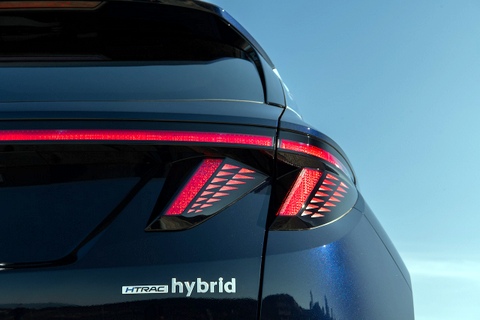
Ride and Handling
The Tucson Hybrid has a pleasant, solid and confident feel. The ride is comfortable with only the harshest road imperfections transmitting sounds to the cabin. The suspension has been programmed and designed so cornering was quite good with little-to-no body roll when pushed hard. The power assisted steering was direct and gave good road feedback, with the ABS regenerative brakes (the system that puts electricity back into the battery when coasting or stopping) had a progressive feel, producing straight and true stops.
A big “Thanks!” to Hyundai for being among the only hybrid manufacturer to put paddles on the steering wheel to adjust the regenerative braking level. Most EVs have this, but it is rare and appreciated to find it on a hybrid.
Easy Identifier
The Tucson Hybrid has what Hyundai calls “Sensuous Sportiness” that was first introduced on the 2021 model. Most of the exterior changes are subtle (but differ between trims) and key on the new boxier front bumper and a new design for the daytime running lights (DRL) imbedded in the revised grille. When a 2025 Tucson or Santa Cruz are coming towards you at night, they are easily identified as no other car, truck or SUV has this lighting signature.

The geometric DRL design of dimensional rectangles is striking upon first glance, but doesn’t get old after repeated viewing. The LED headlights sit on the far edges outside the grille. It’s the sort of front end that, when the lights are on, makes you check it out one more time as you walk away.
The sides reveal interesting dimensional lines with a bold chrome accent strip above the windows. The panoramic power sunroof sits between the aerodynamic roof rails, which lead to a small spoiler over the rear window. Bravo to Hyundai for cleanly tucking the rear wiper under the spoiler, a classy look only more expensive SUVs have adopted.
The distinctive rear end design is dominated by slanted, vertical LED tail lights and a connecting light strip, stretching from edge-to-edge on the power hands-free lift gate.
Clean, Refreshing Interior
The interior, with an open feel, has been completely redesigned for 2025, with the panoramic curved display as the centerpiece. The low slung dash has dual horizontal 12.3-inch color touchscreens that appear to be all one screen.
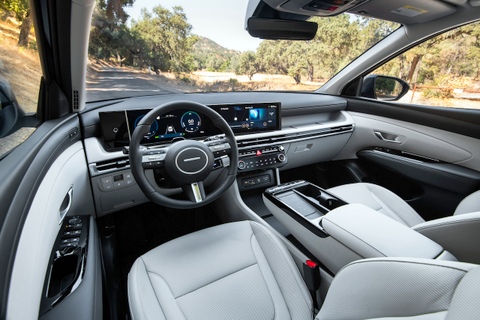
The right side screen houses the navigation, rear view camera, and (standard in the N Line and Limited) the 8-channel Bose premium audio system with eight speakers. This good sounding system has SiriusXM (3-month trial), AM/FM/HD radio, Android Auto and Apple CarPlay. Bluetooth, aux and dual USB Type-C ports complete the audio system. The tilt and telescoping 3-spoke leather-wrapped and heated steering wheel has controls for audio, telephone and the adaptive cruise control.
The left side 12.3-inch color instrument cluster includes easy-to-read speedometer and tachometer gauges with black faces with white letters. This cluster is fully programmable to show various vehicle systems.
Additional features include a proximity key with push button start and adaptive cruise control with stop & go. A nice feature is that dual automatic temperature control is voice-controlled. Smartly, the wireless phone charger has been moved to the top of the center console. Heated and power side mirrors with turn signals and a cargo area 12V charge port round out the features.
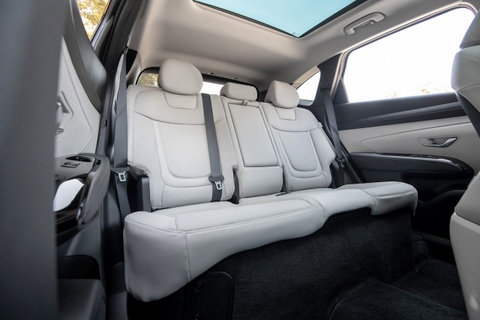
The cabin was quiet as Hyundai added soundproof glass on the windshield and front door windows plus carpet, floor mats and sound absorption materials. Hyundai spokespersons said they listen to automotive journalists and customers when it comes to design, so they have returned to knobs for tuning the audio and the climate systems.
The 2025 Tucson is six inches longer than the outgoing model, with the interior benefiting with more leg room and space to spread out. The front seats in the Limited, which is the top trim level, are 8-way power adjustable, leather-trimmed, heated and ventilated, with the driver getting lumbar and memory.
The second row access was excellent, with the comfortable, three-person seating featuring heated, leather-trimmed seats offering ample head and leg room. The rear passengers get A/C and heater vents, map lights, dual USB ports and a center armrest with cup holders. Cargo space measures 38.7 cubic inches with the rear seat up, and 74.5 with the 60:40 rear seat folded flat. There is additional storage space under the far rear cargo area floor.
MyHyundai technology includes the Hyundai Blue Link app, which provides access to vehicle systems including remote start, and the Digital Key providing extra convenience and safety.
Safety and Warranties
The Tucson Hybrid comes with an extensive list of standard safety features. They include eight airbags (front, side impact and side air curtain with rollover sensors), rain-sensing wipers, lane keeping assist, blind spot detection, forward collision avoidance, rear cross-traffic avoidance assist, hill start assist, surround and blind view monitor with parking sensors, a tire pressure monitoring system and electronic stability control.
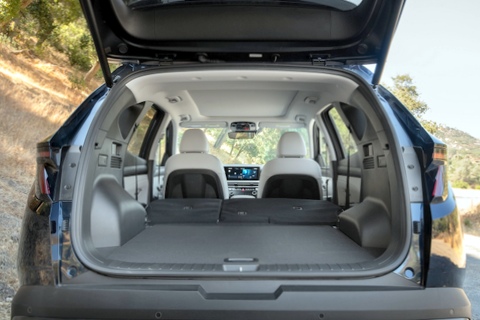
One very cool feature on the Limited trim is the Blind Spot View Monitor. When using the right or left turn signal, a camera comes on showing a view of cars in the lane you’re turning into.
The Forward Attention Warning safety feature tracks the driver’s eye gaze. If the driver is unresponsive, the adaptive cruise control will bring the Tucson to a stop, activating the hazard lights and the electronic parking brake. All well and good, but it repeatedly reminded me to “Keep my eyes on the road,” which was curious as I had yet to drive into a ditch and was not experimenting driving with a blindfold.
The Insurance Institute for Highway Safety (IIHS) awarded the Tucson Hybrid its Top Safety Pick. The National Highway and Safety Administration (NHTSA) gave the 2025 Tucson Hybrid a 5 Star Rating, its highest safety mark.
The 2025 Tucson Hybrid comes with these warranties:

- Hybrid Systems – 10 years/100,000 miles
- Powertrain – 10 year/100,000 miles
- New Vehicle – Five years/60,000 miles
- Complimentary Maintenance – Three years/36,000 miles
- Roadside Assistance – Five years/Unlimited miles
- Anti-perforation – Seven years/Unlimited miles
Pricing
The 2025 Tucson Hybrid AWD comes in four trim levels, all with all-wheel drive. These base prices include the mandatory $1,395 freight charges.
- Blue $34,510
- SEL Convenience $37,610
- N Line $39,260
- Limited $42,340
Observations: 2025 Hyundai Tucson Hybrid
Hyundai isn’t sitting still when it comes to its best-selling vehicle. Brad Arnold, head of exterior design at Hyundai North America, said “We are Hyundai people, and I say that because it is really important for us to make every Hyundai design the best Hyundai design, better than the one we did last time.”

So how did Hyundai do with what they say are “comprehensive changes?” The exterior has been updated and the interior completely redesigned. Combine the looks and features with an efficient hybrid system, a choice of three power plants, two special trims of N for appearance and XRT for the outdoor-focused. With all that, the refreshed 2025 Tucson Hybrid hit the right notes during our brief time behind the wheel.
Go into a Hyundai dealer for a lengthy test drive and see why the Tucson is the best-selling Hyundai.
Make sure to opt-in to the Clean Fleet Report newsletter (top right of page) to be notified of all news stories and vehicle reviews.
Story by John Faulkner. Photos by John Faulkner and Hyundai.
Disclosure:
Clean Fleet Report is loaned free test vehicles from automakers to evaluate, typically for a week at a time. Our road tests are based on this one-week drive of a new vehicle. Because of this we don’t address issues such as long-term reliability or total cost of ownership. In addition, we are often invited to manufacturer events highlighting new vehicles or technology. As part of these events we may be offered free transportation, lodging or meals. We do our best to present our unvarnished evaluations of vehicles and news irrespective of these inducements.
Our focus is on vehicles that offer the best fuel economy in their class, which leads us to emphasize electric cars, plug-in hybrids, hybrids and diesels. We also feature those efficient gas-powered vehicles that are among the top mpg vehicles in their class. In addition, we aim to offer reviews and news on advanced technology and the alternative fuel vehicle market. We welcome any feedback from vehicle owners and are dedicated to providing a forum for alternative viewpoints. Please let us know your views at publisher@cleanfleetreport.com.

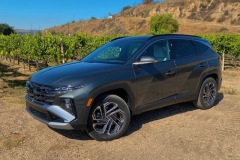
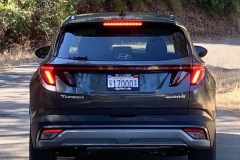
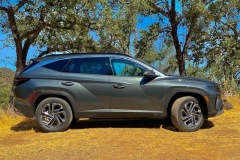
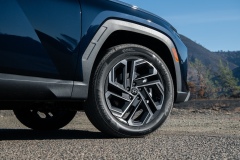
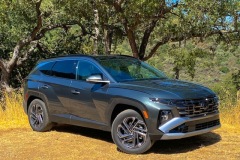
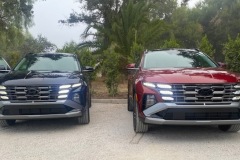


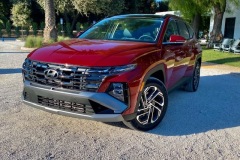

5 thoughts on “Flash Drive: 2025 Hyundai Tucson Hybrid”